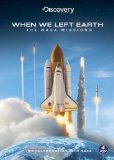| Reviews & Columns |
|
Reviews DVD TV on DVD Blu-ray 4K UHD International DVDs In Theaters Reviews by Studio Video Games Features Collector Series DVDs Easter Egg Database Interviews DVD Talk Radio Feature Articles Columns Anime Talk DVD Savant Horror DVDs The M.O.D. Squad Art House HD Talk Silent DVD
|
DVD Talk Forum |
|
|
| Resources |
|
DVD Price Search Customer Service #'s RCE Info Links |
|
Columns
|
|
|
When We Left Earth - The NASA Missions
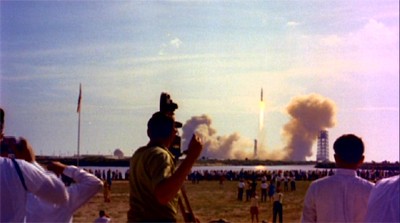
I may have missed the whole space race of the 1960's, but I have always been fascinated by it. NASA's space program, flights to the moon and anything involving astronauts continue to hold my interest long into adulthood. If there's a shuttle flight, I'm watching it, and if there's news regarding some discovery made by the Hubble Telescope, you'd better believe that I'm paying attention. Because of this I make it a point to watch shows such as Earth to the Moon and many of the documentary series involving space. The latest title released by Discovery, When We Left Earth, just so happens to be one of the best ever put together.
Originally airing in June of 2008, When We Left Earth is a in depth look at the NASA program from its brave first steps to now. The real meat of this show comes from the collaborative efforts between Discovery and NASA. Digging into the NASA archives never before seen footage from both the Control Room and inside the space capsule are cleaned up and put on display. Training clips, news conferences, and other rare pieces of footage are also assembled here in an effort to celebrate NASA fiftieth anniversary. All together six, two-hour episodes were produced for the show, and though that doesn't seem like it would be enough, this stuff is like candy for space and science geeks.
Fittingly, the show begins with the Mercury Program, which had the first successful mission of putting a man beyond our atmosphere. The first episode, "Ordinary Supermen", showcases the Mercury Seven and their quest to go to the stars. Riding atop the most powerful rocket ever assembled, these brave astronauts work with NASA to beat the Russians into space. Alan Shepard becomes the first American in space and John Glen is the first American to orbit the Earth. Footage from both missions is included here with commentary from surviving members of the team and officials at NASA. The Mercury Program went on to be a success and during this time Kennedy issued the challenge of being the first to land a man on the moon and bring him back.
Now that the challenge had been issued, NASA was under pressure to get results and launched one unprecedented mission after another. Of course along the way they were behind the Russian space program, but that didn't deter them. Mercury presented NASA with many opportunities to learn, but it wouldn't be until Project Gemini that we conducted our first E.V.A. (extra-vehicular activity). That particular act is featured in the second episode, "Friends and Rivals", but it also goes on to show the first orbital rendezvous of two crafts and Neil Armstrong's space docking.
Episodes three and four focus on the Apollo missions which, of course, feature our first steps on the moon and the disastrous Apollo 13 mission. The show then goes on to talk about Skylab for a tad and shifts over to a more modern discussion with the Shuttle, Hubble Telescope, and International Space Station as topics. While the latter discussions are fascinating in their own right, When We Left Earth is at its best when talking about the earlier missions of NASA as it digs out the archival footage. Even so, learning more about the ill-fated Challenger and Columbia crews was heart-wrenching. Loved ones and comrades appear here to talk about the astronauts and share their personal experiences.
While information about each of NASA's missions has been available for quite some time and covered in many articles and documentaries, it has never been presented quite like this. When We Left Earth doesn't just talk about the successful or scrubbed missions, the technology, and it's not a biography for the astronauts. When We Left Earth is a story.
The narrative here is very strong and it is somewhat sensationalized, but I suppose that's part of the charm. Even though you know what happened with each mission, you can't help but feel like you're on the edge of your seat. Because of that this series extends its life beyond just being a simple documentary and it becomes something special. It's perfectly paced, fascinating from start to finish, and space-lovers everywhere will be transfixed from the moment it starts.
The rare archival footage paints a fine picture of each event and offers video that we've never seen before. Clips from space, on the launch pad, in training, and even just random bits depicting the astronauts playing around really propel this show above other documentaries. It's an unprecedented look at NASA's history and some of the most important people involved in our ascent to space. As cool as it all is though, the archived video only tells part of the story. The real heart of When We Left Earth comes from its many commentators and interviewees who share their experiences and what was going through their minds at particular moments. This gives the show a much needed jolt of humanity, and it humbles NASA to some degree.
Whether you consider yourself a space junkie or not, missing When We Left Earth would be a mistake. This landmark series leaves a powerful impression on you while you watch it, and it's a show that will stick with you long after the final episode's credits roll. It's an emotional experience that catalogues NASA's attempt to do the seemingly impossible and it's mesmerizing every step of the way. The archival footage, commentary, and story all come together in one fine package that almost feels too short because once you start watching it you won't want it to end.
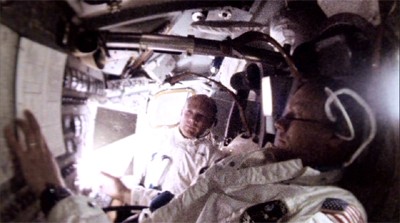
The DVD:
When We Left Earth is presented on DVD with a 1.78:1 anamorphic widescreen aspect ratio. The important thing to remember when watching this show is that a lot of the material is cleaned up archival stuff. That means most of what you're going to see here is blanketed by layers of grain, faded by years, and otherwise very dated looking. With that being said it's worth noting that one heck of a cleanup job was done for this footage. Old newsreel clippings and NASA videos are MUCH cleaner than they should be and in many cases it's very hard to tell that you're watching video from forty years ago. The modern material is obviously much sharper and the interview segments offer some outstanding quality. All in all this is a fantastic looking documentary series, and though it has its ups and downs it's definitely a step up from most shows of its kind.
When We Left Earth comes with Dolby Digital 5.1 and 2.0 audio tracks to select from, though the obvious choice for viewing here is the 5.1. For a documentary style series, the rear channels actually get some nice use during liftoff moments and bits where the music chimes in. Otherwise you can expect the sense of immersion to be very minimal as most of the show comes through from the front channels. This isn't necessarily a bad thing, since this is a dialogue driven documentary, but some more use of the soundstage would have been appreciated. Gary Sinise provides the narration and the interview segments all offer great clarity, but some of the archival stuff is rough around the edges as you'd expect. Optional English and Spanish subtitles are included as well.
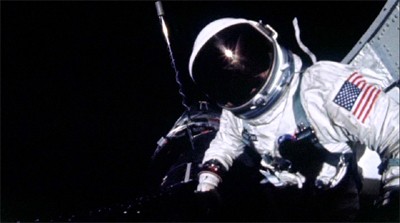
Each of the three discs featuring episodes of the show offer some bonus content, but the real wealth of supplemental material is available on the fourth disc. Packed in with the collection is a foldout timeline with information about the episodes and depictions of each significant event and where they fell throughout the years.
The first disc includes "Highlights From the NASA Film: Four Days of Gemini 4" (6:38). This feature is a look at the Gemini 4 mission of conducting the first E.V.A. with some additional footage that was not used during the episode in the show. This footage offers a nice comparison if you wanted to see what the original looked like versus how the show looked all cleaned up. Otherwise there's not much here that expands upon what was already presented in the show. Two archival interview segments are included with Michael Collins and Joe Kosmo. These offer some more insight behind some of NASA's missions and inner workings. Additional bonus content takes a look at some more archival clips from NASA such as the Mercury Training, Ed White's E.V.A., and snippets from Gemini 6, 7, 8, and 9.
Disc two features a similar batch of bonus features with more highlights from another NASA film "Apollo 13: Houston We've Got a Problem" (9:08). Obviously this one focuses on what went wrong with Apollo 13 and how the boys were brought back home. Further interviews are included with Al Bean and Gene Kranz, and there are more mission clips which feature Apollo 8, 9, 11, 16, and 17. These are all nice additions to the content already included in When We Left Earth and help to make the set feel even more complete.
Once again the theme of the bonus features remains the same for the third disc. "Skylab: The First 40 Days" (7:39) is an interesting archival film about Skylab that was produced many years ago. Shannon Lucid and James Crocker appear in additional interviews here, and more mission clips are featured including two Skylab ones, and four shuttle missions.
While the bonus features on each of the three discs are interesting, the material contained on the fourth is by far the richest and rarest. Five really old documentaries are packed onto the disc here and they could easily have been a separate DVD release all by themselves. "Freedom 7" (28:12) looks at the Mercury vessel, its crew, and its mission, "Friendship 7: John Glenn" (58:06) is a very comprehensive documentary about Glenn's mission, and "Proud Conquest: Gemini VII & VI" (29:11) looks at a pair of successful Gemini missions. The final two documentaries, "Apollo 8 Debrief" (27:33) and "The Flight of Apollo 11" (28:24) put a nice finishing touch on the series of historical documentaries from the archives. As you can see, the final disc includes nearly three hours of additional bonus content alone and if you appreciated the content from the actual show here, you'll eat this stuff right up.
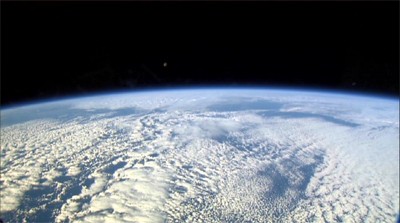
I realize that I've been gushing about When We Left Earth from the moment I started writing this review. In all honesty, it is without a doubt one of most comprehensive and finely produced documentaries about spaceflight and NASA ever put together. The archival footage offers a rare glimpse behind the scenes of NASA and with the restored quality it's almost like the show peers through time. Even though these clippings are from well-documented history and we know how things wound up, you can't help but be on the edge of your seat for much of the program. Once you're done with the show the wealth of bonus content definitely extends the viewing of the set. All together this is a comprehensive look at NASA that is not to be missed.
Check out more of my reviews here. Head on over to my anime blog as well for random musings and reviews of anime, manga, and stuff from Japan!
|
| Popular Reviews |
| Sponsored Links |
|
|
| Sponsored Links |
|
|
| Release List | Reviews | Shop | Newsletter | Forum | DVD Giveaways | Blu-Ray | Advertise |
|
Copyright 2024 DVDTalk.com All Rights Reserved. Legal Info, Privacy Policy, Terms of Use,
Manage Preferences,
Your Privacy Choices | |||||||









